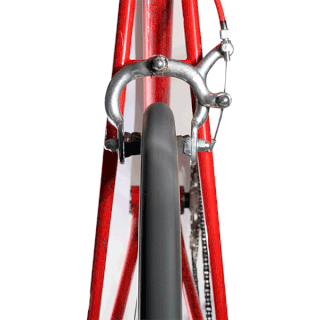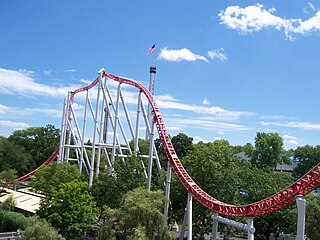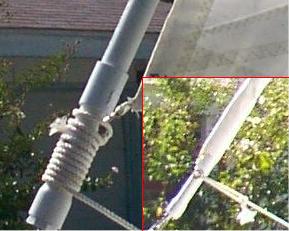In engineering, a fail-safe is a design feature or practice that in the event of a specific type of failure, inherently responds in a way that will cause no or minimal harm to other equipment, to the environment or to people. Unlike inherent safety to a particular hazard, a system being "fail-safe" does not mean that failure is impossible or improbable, but rather that the system's design prevents or mitigates unsafe consequences of the system's failure. That is, if and when a "fail-safe" system fails, it remains at least as safe as it was before the failure. Since many types of failure are possible, failure mode and effects analysis is used to examine failure situations and recommend safety design and procedures.

A bicycle brake reduces the speed of a bicycle or prevents it from moving. The three main types are: rim brakes, disc brakes, and drum brakes. There have been various types of brakes used throughout history, and several are still in use today.

A jibe (US) or gybe (Britain) is a sailing maneuver whereby a sailing vessel reaching downwind turns its stern through the wind, such that the wind direction changes from one side of the boat to the other. For square-rigged ships, this maneuver is called wearing ship.
An actuator is a component of a machine that is responsible for moving and controlling a mechanism or system, for example by opening a valve. In simple terms, it is a "mover".

An elevated passenger ropeway, or chairlift, is a type of aerial lift, which consists of a continuously circulating steel cable loop strung between two end terminals and usually over intermediate towers, carrying a series of chairs. They are the primary onhill transport at most ski areas, but are also found at amusement parks, various tourist attractions, and increasingly in urban transport.

A sea anchor is a device that is streamed from a boat in heavy weather. Its purpose is to stabilize the vessel and to limit progress through the water. Rather than tethering the boat to the seabed with a conventional anchor, a sea anchor provides drag, thereby acting as a brake. Normally attached to a vessel's bows, a sea anchor can prevent the vessel from turning broadside to the waves and being overwhelmed by them.
A preventer, or jibe-guard, is a mechanical device on a sailing vessel which limits the boom's ability to swing unexpectedly across the boat due to an unplanned accidental jibe.
A brake run on a roller coaster is any section of track meant to slow or stop a roller coaster train. Brake runs may be located anywhere along the circuit of a coaster and may be designed to bring the train to a complete halt or to simply adjust the train's speed. Contrary to some belief, the vast majority of roller coasters do not have any form of braking on the train itself, but rather forms of braking that exist on track sections. One notable exception is the Scenic Railway roller coaster, which relies on an operator to manually control the speed of the train.

In sailing, a boom is a spar (pole), along the of a fore and aft rigged sail, that greatly improves control of the angle and shape of the sail. The primary action of the boom is to keep the foot flatter when the sail angle is away from the centerline of the boat. The boom also serves as an attachment point for more sophisticated control lines. Because of the improved sail control it is rare to find a non-headsail without a boom, but lateen sails, for instance, are loose-footed. In some modern applications, the sail is rolled up into the boom for storage or reefing.

A linear actuator is an actuator that creates motion in a straight line, in contrast to the circular motion of a conventional electric motor. Linear actuators are used in machine tools and industrial machinery, in computer peripherals such as disk drives and printers, in valves and dampers, and in many other places where linear motion is required. Hydraulic or pneumatic cylinders inherently produce linear motion. Many other mechanisms are used to generate linear motion from a rotating motor.

Sail twist is a phenomenon in sailing where the head of the sail is at a different angle of incidence from the foot of the sail in order to change the lift distribution with height. Twist is measured by comparing the angle of a straight line between the leading edge (luff) and trailing edge (leech) with that of the boom. Some twist is desirable, but too much can induce weather helm or ruin the slot between the mainsail and jib.

A hydraulic brake is an arrangement of braking mechanism which uses brake fluid, typically containing glycol ethers or diethylene glycol, to transfer pressure from the controlling mechanism to the braking mechanism.

In road vehicles, the parking brake, also known as a hand brake or emergency brake (e-brake), is a mechanism used to keep the vehicle securely motionless when parked. Historically, it was also used to help perform an emergency stop should the main hydraulic brakes fail. Parking brakes often consist of a cable connected to two wheel brakes, which is then connected to a pulling mechanism. In most vehicles, the parking brake operates only on the rear wheels, which have reduced traction while braking. The mechanism may be a hand-operated lever, a straight pull handle located near the steering column or a foot-operated pedal located with the other pedals.

Storm Runner is a launched roller coaster located at Hersheypark in Hershey, Pennsylvania. Manufactured by Intamin and situated in the Pioneer Frontier section of the park, the Accelerator Coaster opened to the public on May 8, 2004. It reaches a height of 150 feet (46 m) and catapults riders from 0 to 72 mph (116 km/h) in two seconds. Storm Runner features a top hat element, three inversions, a dual loading station and a magnetic braking system. In addition, it was designed to interact with three other Hersheypark rides: Dry Gulch Railroad, the Monorail, and Trailblazer.

Roller furling is a method of furling a yacht's staysail by rolling the sail around a stay. Roller furling is typically used for foresails such as jibs or genoas.
Electromagnetic brakes slow or stop motion using electromagnetic force to apply mechanical resistance (friction). The original name was "electro-mechanical brakes" but over the years the name changed to "electromagnetic brakes", referring to their actuation method. Since becoming popular in the mid-20th century especially in trains and trams, the variety of applications and brake designs has increased dramatically, but the basic operation remains the same.

Electric park brakes (EPB) are used on passenger vehicles to hold the vehicle stationary on grades and flat roads. This was accomplished traditionally using a manual parking brake. With electric park brakes, the driver activates the holding mechanism with a button and the brake pads are then electrically applied onto the rear brakes. This is accomplished by an electronic control unit (ECU) and an actuator mechanism. There are two mechanisms that are currently in production: 1. Cable puller systems and 2. Caliper integrated systems. EPB systems can be considered a subset of Brake-by-wire technology.

DC injection braking is a method of slowing AC electric motors. A DC voltage is injected into the winding of the AC motor after the AC voltage is disconnected, providing braking force to the rotor.

Mountain bike trials, also known as observed trials, is a discipline of mountain biking in which the rider attempts to pass through an obstacle course without setting foot to ground. Derived from motorcycle trials, it originated in Catalonia, Spain and is said to have been invented by the father of Ot Pi, a world champion motorcycle trials rider. Pi's father had wanted his son to learn motorcycle trials by practicing on an ordinary bicycle.














